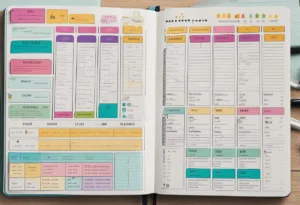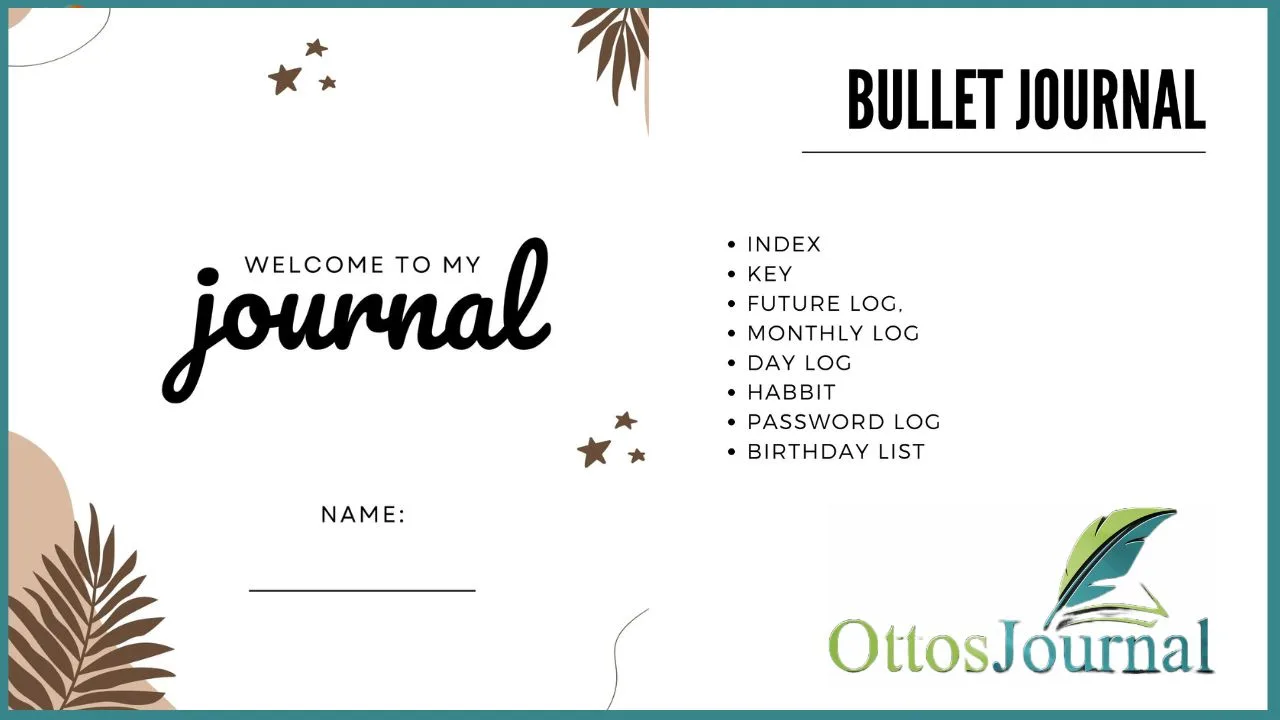Bullet journaling is a popular way to track habits, goals, and daily tasks. However, it can also be used to track symptoms related to chronic illnesses. A symptom tracker bullet journal is a useful tool for people who want to manage their health and keep track of their symptoms in a convenient and organized way.
Creating a symptom tracker bullet journal involves designing a layout that works for the individual’s needs. The journal can include daily symptom logs, medication tracking, and other health-related information. It can be used to track habits that may affect health, such as exercise, sleep, and diet. By using a symptom tracker bullet journal, individuals can gain insight into their health patterns and make informed decisions about their care.
Setting Up Your Symptom Tracker
Choosing a Bullet Journal
When setting up a symptom tracker, it is important to choose a bullet journal that suits your needs. There are many types of bullet journals available, ranging from pre-made templates to printable free printables. Some bullet journals come with pre-made symptom tracker templates, while others require customization. It is important to choose a bullet journal that is easy to use and customize, as this will make tracking your symptoms more efficient.
Symptom Tracker Basics
When setting up a symptom tracker, it is important to understand the basics. A symptom tracker is a tool used to record and monitor symptoms over time. It can help identify patterns and triggers, as well as track progress and treatment effectiveness.
To set up a basic symptom tracker, start by creating a list of symptoms you want to track. Then, create a chart or table to record the date, symptom severity, and any other relevant information.
Customizing Your Tracker Layout
Customizing your symptom tracker layout can help make tracking your symptoms more efficient and enjoyable. Some people prefer to use a simple table or chart, while others prefer a more creative layout.
It is important to choose a layout that works for you and your needs. Consider adding color-coding, symbols, or images to make your tracker more visually appealing. Using stickers or washi tape can help make your tracker more fun and personalized.
Recording Symptoms and Triggers
Keeping a record of symptoms and triggers is an essential part of managing a chronic condition. A bullet journal is a great tool for this purpose, as it allows for easy tracking and analysis of symptoms and triggers.
Daily Symptom Log
The first step in symptom tracking is to create a daily symptom log. This log should include a record of all symptoms experienced each day, along with their severity and duration. It can be helpful to use a scale to rate the severity of symptoms, such as a 1-10 scale.
Identifying Triggers and Stressors
Identifying triggers and stressors is an important part of managing a chronic condition. In the bullet journal, a separate section can be created to track potential triggers and stressors. This section should include a record of any events or activities that may have triggered symptoms, as well as any stressors that may have contributed to symptom flare-ups.
Correlating Symptoms with Activities
Correlating symptoms with activities can help identify patterns and triggers. In the bullet journal, a table can be created to record symptoms alongside any activities or events that occurred on the same day. This can help identify any patterns or correlations between certain activities and symptom flare-ups.
Keeping a symptom tracker bullet journal can be a valuable tool in managing chronic conditions. By recording symptoms, identifying triggers and stressors, and correlating symptoms with activities, individuals can gain a better understanding of their condition and make informed decisions about their treatment plan.
Monitoring Health and Well-being
Tracking Physical Health
Keeping track of one’s physical health is essential for maintaining a healthy lifestyle. A symptom tracker bullet journal can be a great tool for tracking physical health. By recording symptoms, pain levels, and medication use, individuals can identify patterns and make informed decisions about their health.
A table format can be used to record data, with columns for date, symptom, severity level, and medication taken. This will help individuals keep track of their symptoms and monitor their overall health.
Mental Health and Mood Monitoring
Mental health and mood monitoring are crucial for overall well-being. A bullet journal can be used to track mood changes, anxiety levels, and stress levels. By monitoring these factors, individuals can identify triggers and develop coping mechanisms. A mood tracker can be used to record daily moods and identify patterns. A table format can be used to record data, with columns for date, mood, and any triggers or coping mechanisms used.
Sleep and Energy Levels
Sleep and energy levels are essential for maintaining overall health and well-being. A sleep tracker can be used to record sleep patterns and identify any issues with sleep quality. By monitoring energy levels throughout the day, individuals can identify patterns and make lifestyle changes to improve their overall health. A table format can be used to record data, with columns for date, hours of sleep, and energy levels throughout the day.
A symptom tracker bullet journal can be a useful tool for monitoring health and well-being. By tracking physical health, mental health, mood, sleep, and energy levels, individuals can identify patterns and make informed decisions about their health. A bullet journal can be customized to meet individual needs and preferences, making it a versatile and effective tool for tracking health and well-being.
Analyzing Patterns and Progress
Tracking symptoms in a bullet journal can help individuals with chronic conditions spot trends, evaluate medication efficacy, and assess the impact of lifestyle changes.
Spotting Trends in Symptoms
By tracking symptoms over time, individuals can identify patterns that may be related to specific triggers or events. For example, a person with migraines may notice that their headaches tend to occur more frequently during times of stress. This information can help the individual take steps to reduce stress and prevent future headaches.
Evaluating Medication Efficacy
Tracking medication use and symptom severity can help individuals evaluate the effectiveness of their treatment plan. By comparing symptom severity before and after starting a new medication, individuals can determine if the medication is providing relief. If the medication is not effective, the individual can discuss alternative treatment options with their healthcare provider.
Assessing Lifestyle Changes Impact
Tracking lifestyle factors such as diet, exercise, and sleep can help individuals identify changes that may be impacting their symptoms. For example, a person with Crohn’s disease may notice that their symptoms improve when they eat a low-fiber diet. By tracking their diet and symptoms, the individual can determine if this dietary change is effective for them.
Tracking symptoms in a bullet journal can provide valuable insights into an individual’s condition and treatment plan. By analyzing patterns and progress, individuals can make informed decisions about their health and work with their healthcare provider to develop an effective treatment plan.
Symptom Tracker Bullet Journal Ideas
Keeping track of symptoms is essential for people suffering from chronic illnesses. A bullet journal can be an effective way to monitor symptoms, identify triggers, and track progress. Here are some symptom tracker bullet journal ideas that can help:
Habit Tracker
A habit tracker can be used to monitor daily routines and habits that may impact symptoms. This can include tracking sleep patterns, medication schedules, and dietary habits. By monitoring these habits, individuals can identify patterns that may trigger symptoms and work to adjust them accordingly.
Exercise Tracker
Exercise has been shown to improve symptoms for many chronic illnesses. An exercise tracker can be used to monitor the frequency and intensity of exercise, as well as any changes in symptoms that may occur as a result.
Weight Loss Tracker
Being overweight can exacerbate symptoms for many chronic illnesses. A weight loss tracker can be used to monitor progress towards weight loss goals and identify any changes in symptoms that may occur as a result.
Goal Tracker
Setting goals can help individuals stay motivated and focused on managing their symptoms. A goal tracker can be used to set and monitor progress towards short-term and long-term goals.
Productivity Tracker
Chronic illness can often impact productivity. A productivity tracker can be used to monitor daily tasks and identify any patterns that may impact productivity. This can help individuals adjust their routines and habits to maximize productivity.
Mood Tracker
Symptoms can often impact mood. A mood tracker can be used to monitor changes in mood over time and identify any patterns that may impact symptoms.
Pain Tracker
Pain is a common symptom for many chronic illnesses. A pain tracker can be used to monitor the frequency and intensity of pain, as well as any changes that may occur as a result of different treatments or lifestyle adjustments.
Symptom Severity Tracker
A symptom severity tracker can be used to monitor changes in symptoms over time. This can help individuals identify triggers and track progress towards managing symptoms.
Symptom Trigger Tracker
A symptom trigger tracker can be used to identify patterns that may trigger symptoms. This can include tracking dietary habits, stress levels, and environmental factors that may impact symptoms. By identifying triggers, individuals can work to adjust their routines and habits to minimize symptom flare-ups.

Frequently Asked Questions
How can I create an effective symptom tracker in my bullet journal?
To create an effective symptom tracker in your bullet journal, start by identifying the symptoms that you want to track. Then, choose a layout that works for you and create a key to help you easily record and track your symptoms. Consider using symbols or colors to visually distinguish between different symptoms.
It’s also helpful to record the date and time of each symptom, as well as any triggers or potential causes. Regularly reviewing your symptom tracker can help you identify patterns and triggers, which can be useful for managing your health.
What are the essential components of a chronic illness symptom tracker for a bullet journal?
The essential components of a chronic illness symptom tracker for a bullet journal include the symptoms you want to track, a key to help you record and track your symptoms, the date and time of each symptom, and any triggers or potential causes.
You may want to include a section for notes or observations, as well as a section to track medication or treatment effectiveness. It’s important to choose a layout that works for you and to regularly review your symptom tracker to identify patterns and triggers.
Can you suggest a layout for a medication tracker in a bullet journal?
A simple layout for a medication tracker in a bullet journal is to create a table with columns for the medication name, dosage, frequency, and notes. You can also include a column to track when you took each dose.
Consider using symbols or colors to visually distinguish between different medications. It’s also helpful to record any side effects or interactions with other medications. Regularly reviewing your medication tracker can help you ensure that you are taking your medications as prescribed and can help you identify any issues or concerns.
How do I integrate a habit tracker into my bullet journal for health monitoring?
Integrating a habit tracker into your bullet journal for health monitoring can be a useful way to track behaviors that impact your health. To create a habit tracker, start by identifying the habits or behaviors you want to track. Then, choose a layout that works for you and create a key to help you easily record and track each habit.
Consider using symbols or colors to visually distinguish between different habits. Regularly reviewing your habit tracker can help you identify areas for improvement and can help you stay motivated to make positive changes.
What is the best way to set up an alcohol consumption tracker in a bullet journal?
To set up an alcohol consumption tracker in a bullet journal, start by identifying the information you want to track, such as the type of alcohol, the amount consumed, and the date and time of consumption. Choose a layout that works for you and create a key to help you easily record and track your alcohol consumption.
Consider using symbols or colors to visually distinguish between different types of alcohol or levels of consumption. Regularly reviewing your alcohol consumption tracker can help you identify patterns and make informed decisions about your drinking habits.
Are there any printable templates available for a health tracker suitable for a bullet journal?
Yes, there are many printable templates available for a health tracker suitable for a bullet journal. A quick online search will yield a variety of options, including templates for symptom tracking, medication tracking, habit tracking, and more.
Consider choosing a template that aligns with your specific health needs and preferences. It’s also important to regularly review and update your tracker to ensure that it remains accurate and useful.



